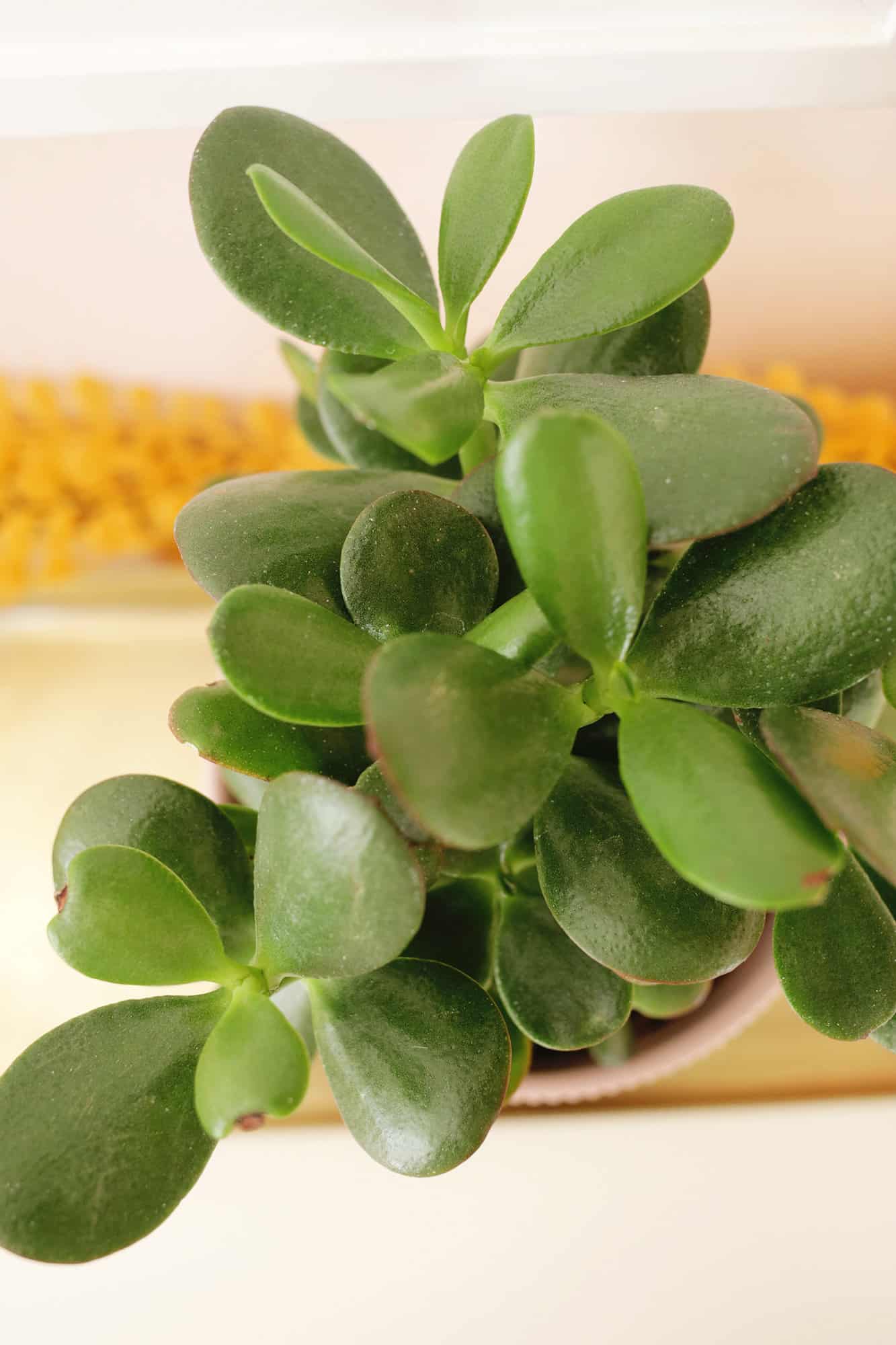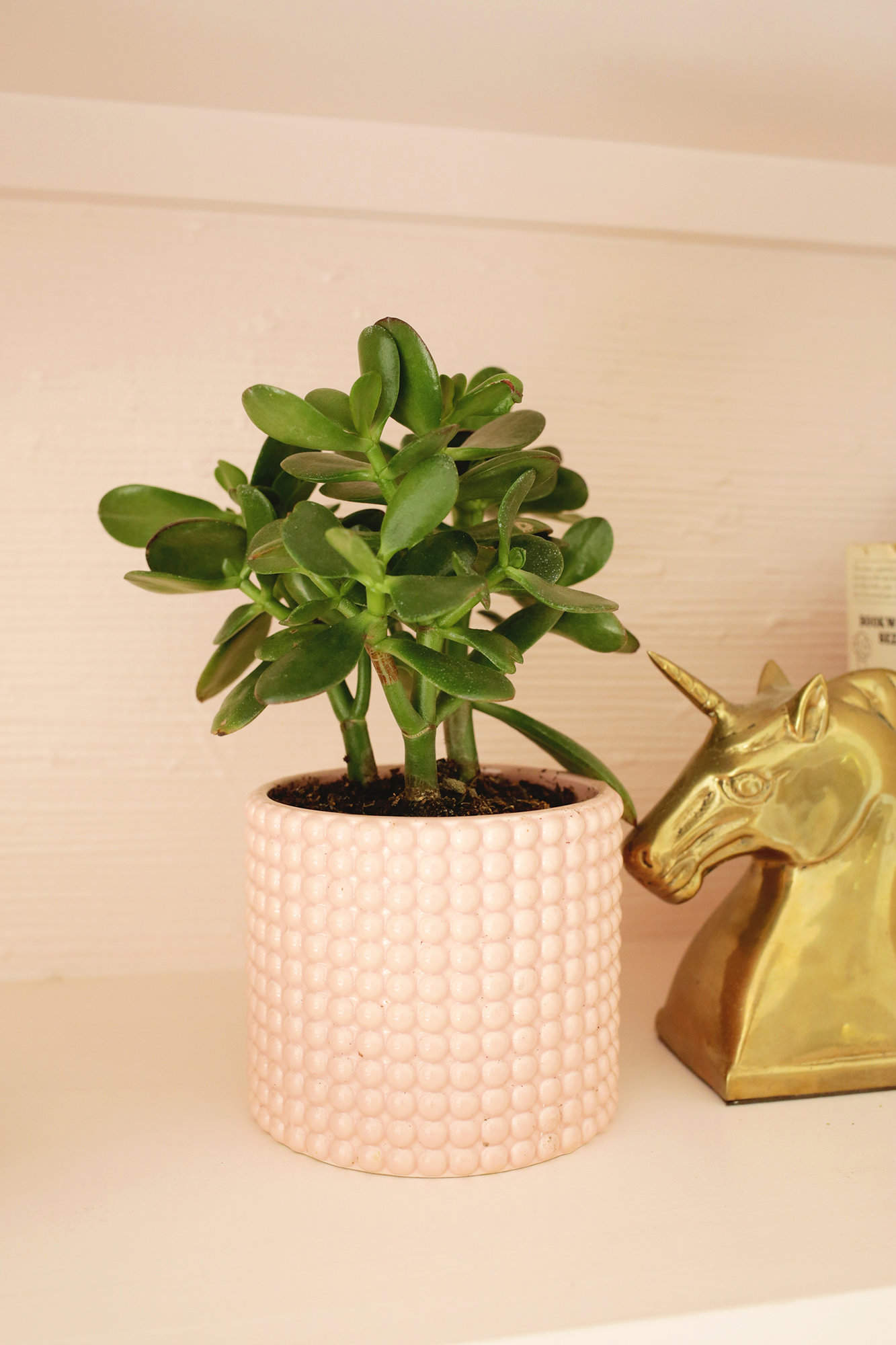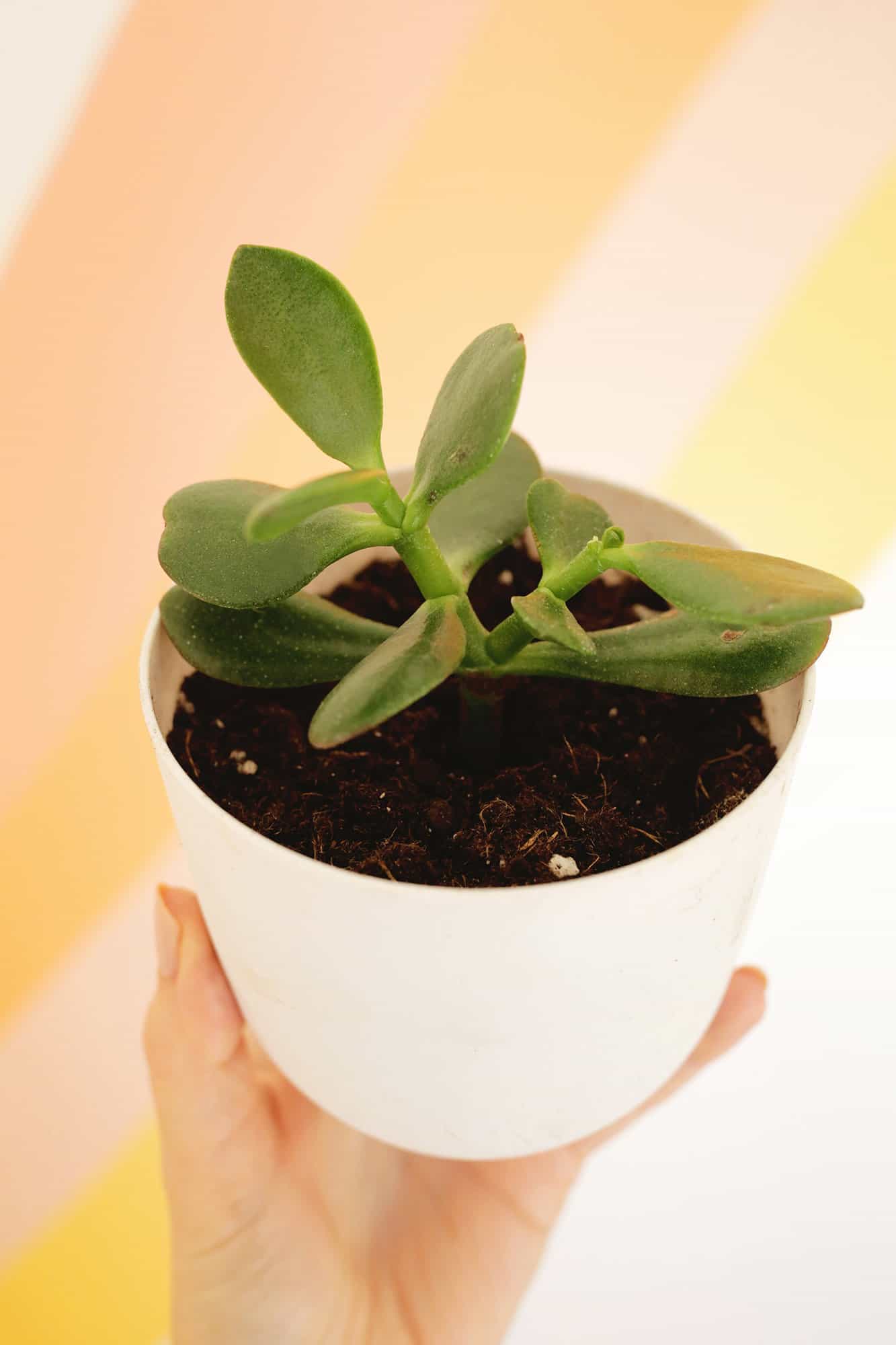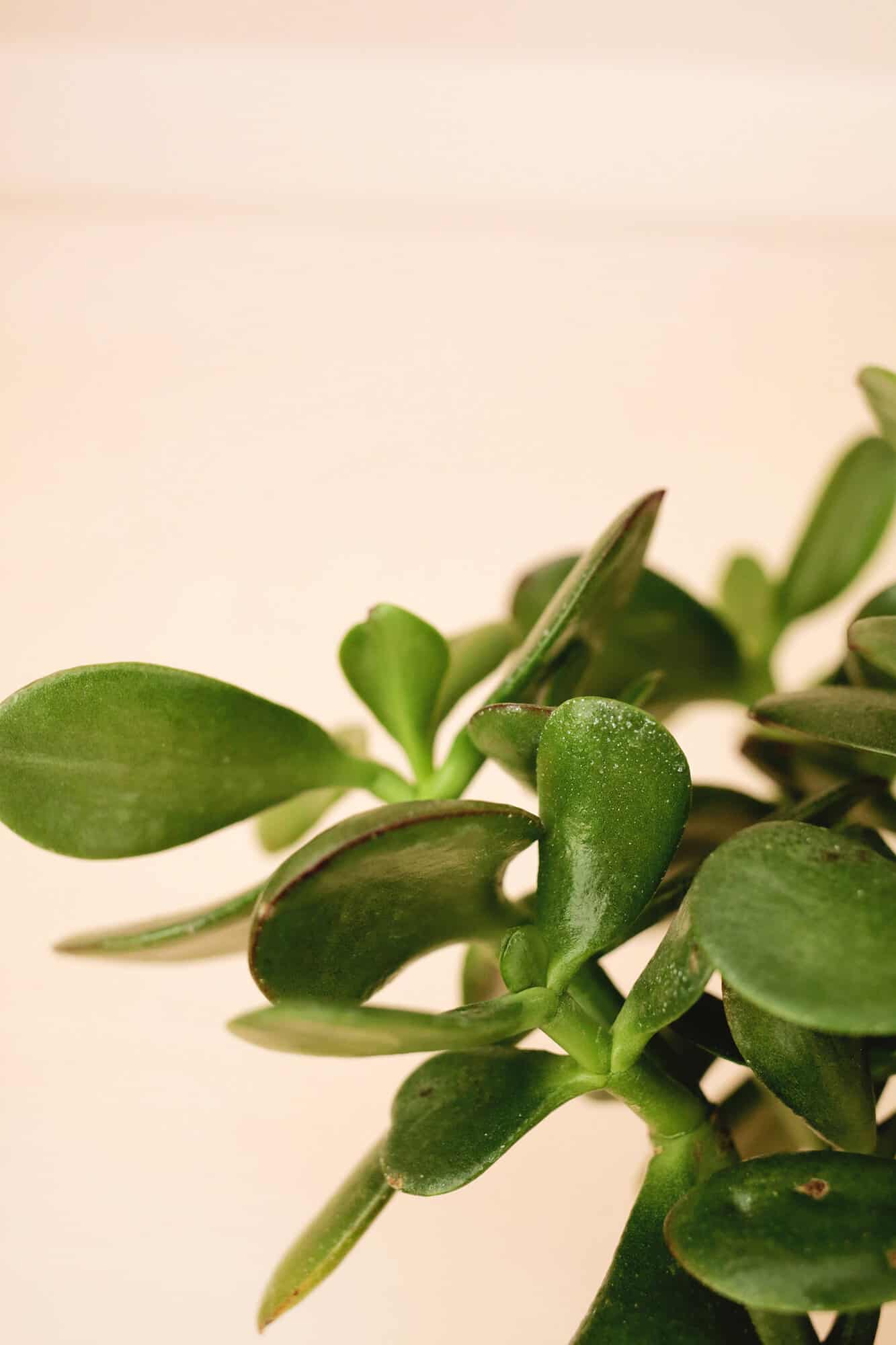Jade plants (Crassula ovata) are a very popular variety of succulent houseplant. Their shape resembles a mini-tree with their woody stems and shiny oval leaves, which makes them popular for bonsai. With the right care, they can live up to 50, or even 100 years, and are sometimes passed down from one generation to the next. They are easy to propagate, so you can grow a whole new plant from a single jade leaf!
These beauties can grow up to 3 feet tall when grown indoors, and while they can be grown outside as well, they will need to come in for the winter if it gets too cold. Jade is a slow growing plant, so don’t expect more than 2 inches of growth a year.
Jade plants are part of the orpine family (Crassulaceae) and native to southern Africa. They don’t need a lot of water as they store water in their fleshy leaves and stems, and they are more OK with being root bound than other plants, so you don’t have to repot them as often as others.
Related: Learn to Care for Pilea Plants, Calathea, Spider Plants, Fiddle Leaf Figs, Golden Pothos, Snake Plants, Rubber Trees, and String of Pearls Plants.

How often should I water jade plants?
Jade plants will need to be watered more in the growing season (spring and summer) and less during the dormant fall and winter months. During the growing season, you’ll want to water the plant so it’s fully wet all the way to the bottom (not just at the top) and then let it get mostly dry before watering again. Overwatering can be a big problem for jade plants, so make sure to let the soil dry out some between waterings.
During the fall and winter, the plant won’t need as much water, so you can let the soil fully dry between waterings. Jade plants can be sensitive to tap water, so using distilled, filtered, or rainwater is ideal.
How much sunlight do jade plants need?
Jade plants are native to hot and sunny environments, so they enjoy being in bright light, about 4-6 hours of it a day. Younger jade plants should be in indirect light but more mature plants can handle some direct sunlight. South and western facing windows will give the best light.
If jade plants don’t get enough bright light, they can become leggy (they will elongate and stretch out rather than looking more compacted as they usually do). Rotate your plant every so often so it doesn’t get lopsided as it will stretch and reach for the sun.

Should I fertilize my jade plant?
Jade plants don’t need a lot of nutrients, so they don’t need to be fertilized much. But you can give it a diluted half-strength dose of fertilizer every two months during the growing season.
Temperature and humidity for jade plants
The ideal temperature for jade plants is between 65° to 75°F when grown indoors. They don’t like to be colder than 50°, so make sure to bring them inside if you keep them outdoors in planters.

Pruning jade plants
Prune in spring or early summer when the plant is starting its growing season. Look for leggy sections that are longer and usually thinner than the other sections with the leaves more spread out. Those leggy areas are less healthy and can be pruned off with sharp scissors or pruning shears by cutting them back one third of their length.
You can also prune any leaves that are yellowing or have dark spots as those can be signs of disease in the plant. Sanitize your cutting shears between cuts so you don’t spread disease to the rest of the plant. Dried and dead branches can be cut where they meet the trunk.
To encourage the plant to grow taller rather than wider, you can also pinch off the new growth of tiny leaves at the end of stems with your fingers.

Repotting jade plants
Jade plants actually do really well being root bound in a small pot. While younger jade plants can be repotted every 2-3 years, more mature plants can be repotted every 4-5 years and you’ll want to choose a pot that’s not much larger than the rootball (too much soil around it can encourage it to hold too much moisture for its liking). If repotting into the same size plant, prune the roots back so there’s room for them to grow.
It’s best to repot in the spring and hold off on watering the newly moved plant for a week or so (and don’t fertilize for a month to avoid damage to the new roots).

Propagating jade plants
You can propagate your jade plant and grow a whole new one from simply planting a stem or even a single leaf! You’ll want to do it before the dormant winter months (summer is best) and only with mature plants.
To propagate:
Cut stem or leaf: Using clean scissors or shears, cut off a 3-4″ stem or gently break off a single leaf.
Allow cutting to “heal”: Let the cutting sit unplanted in a warm space so that a callous will form over the cut area (this will encourage the cutting to grow roots rather than rot).
Plant cutting: Using well-draining potting mix, lay your leaf horizontally on the top of the soil and cover the cut end with some of the soil. Stems can be planted into the soil directly and you can use skewers or toothpicks to prop it up as needed. Don’t water the plant (although you can lightly mist it if you want), just place it in a warm bright place.
Let roots develop: It takes a week or so before the cutting will start to develop roots. You can gently tug on the leaf or stem to see if it has started rooting and once you feel that its roots are firmly developed you can start to water it deeply to encourage the roots to reach down to get the water.

Diagnosing common problems
- Pests: While there aren’t a lot of pests that bother jade plants, mealybugs are the most common problem (they look like small fuzzy white spots). To remove them, you can use a cotton swab dipped in rubbing alcohol and clean the plant daily for several days or weeks to make sure all the bugs have been removed.
- Plant is dropping leaves/brown spots on leaves/shriveled leaves: Your jade plant is probably not getting enough water. Water deeply and let soil dry out some before watering again and make sure to check water levels more in growing season.
- Plant has mushy or squishy leaves: Your plant may be getting too much water. Make sure the soil is almost dry in growing season before watering again and let soil completely dry out before watering in the dormant fall and winter months.
- Plant is losing leaves: Could be a sign that the plant is not getting enough light. Make sure it’s getting 6 hours of bright but indirect sunlight a day.
Frequently Asked Questions
Are jade plants poisonous to pets or kids?
Jade plants are very poisonous to dogs and cats, so you’ll want to keep them away from prying paws. The plant is also mildly poisonous to humans as well, so make sure they aren’t within reach of small children.
